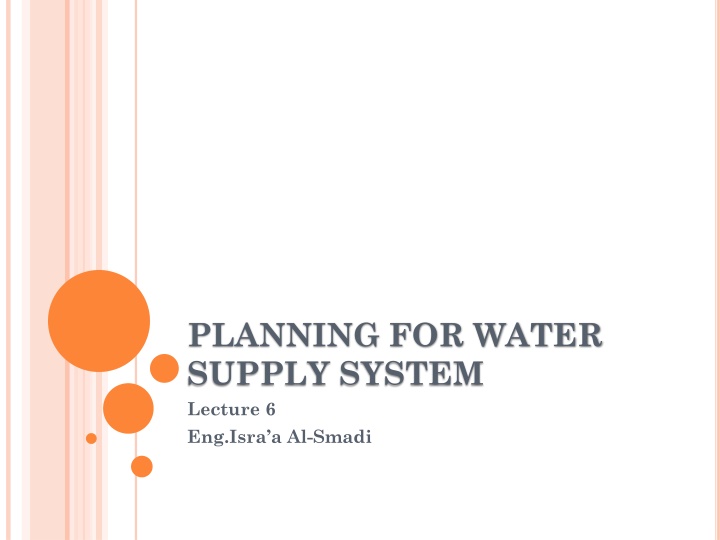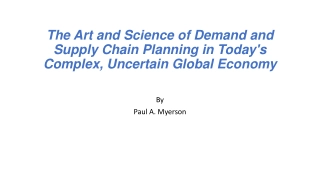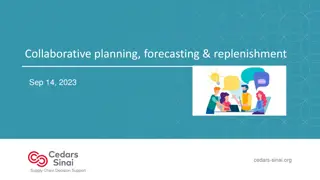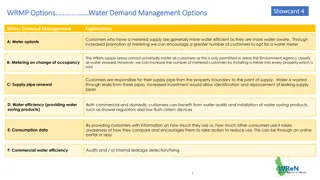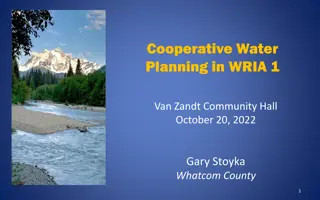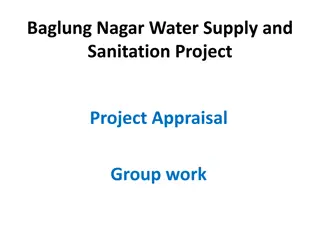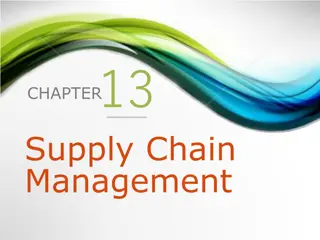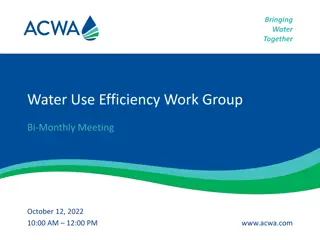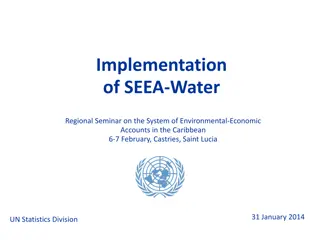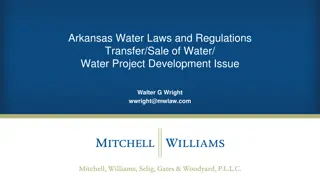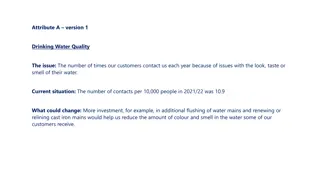PLANNING FOR WATER SUPPLY SYSTEM
Water supply system planning is crucial for ensuring efficient and sustainable access to clean water. In this lecture by Eng. Israa Al-Smadi, key considerations, strategies, and challenges in designing water supply systems are discussed. Topics may include infrastructure development, resource management, and environmental impact assessments. Understanding these aspects is essential for effective urban planning and community development.
Download Presentation

Please find below an Image/Link to download the presentation.
The content on the website is provided AS IS for your information and personal use only. It may not be sold, licensed, or shared on other websites without obtaining consent from the author.If you encounter any issues during the download, it is possible that the publisher has removed the file from their server.
You are allowed to download the files provided on this website for personal or commercial use, subject to the condition that they are used lawfully. All files are the property of their respective owners.
The content on the website is provided AS IS for your information and personal use only. It may not be sold, licensed, or shared on other websites without obtaining consent from the author.
E N D
Presentation Transcript
PLANNING FOR WATER SUPPLY SYSTEM Lecture 6 Eng.Isra a Al-Smadi
WHATARETHEOBJECTIVESOFWATER SUPPLY(DISTRIBUTION) SYSTEM(WDS)? To provide wholesome water to t he consumer for drinking purpose. To supply adequate quantity of water to meet the least minimum needs of the individuals. To make adequate provisions for emergencies like fire- fighting To make provisions for future demand due to the increase in population, To maintain the treatment units and distribution system in good condition with adequate staff and material. To design and maintain the system that is economical and reliable.
WATERSUPPLY(DISTRIBUTION) SYSTEM(WDS) o The distribution system describes collectively the facilities used to supply water from its source to the point of usage. o This may include extensive system of : Pipes storage reservoirs pumps and related appurtenances o The proper functioning of a water distribution system is critical to providing sufficient drinking water to consumers as well as providing sufficient water for fire protection
WATERDEMAND A fundamental prerequisite to begin the design of water supply facilities is a determination of the design capacity. This, in turn, is a function of water demand. o Water demand is :the total quantity of a water required for various purposes by the city.
WATERDEMAND As a matter of fact the first duty of the engineer is to determine the water demand of the town and then to find suitable water sources from where the demand can be met. it is not possible to accurately determine the actual demand. Certain empirical formulae and thumb rules are employed in determining the water demand, which is very near to the actual demand.
WATERDEMAND The determination of water demand consists of four parts: (1) selection of a design period (2) estimation of the population, commercial, and industrial growth (3) estimation of the unit water use (4) estimation of the variability of the demand.
DESIGNPERIOD The design period (also called the design life) is not the same as the life expectancy The design period is the length of time it is estimated that the facility will be able to meet the demand, that is, the design capacity.
DESIGNPERIOD The number of years selected for the design period is based on the following: Regulatory constraints. 1) The rate of population growth. 2) The interest rate for bonds. 3) The useful life of the structures and equipment. 4) The ease or difficulty of expansion. 5) Performance in early years of life under minimum 6) hydraulic load.
DESIGNPERIOD Design periods for water works
ESTIMATIONOFTHEPOPULATION Design Population: It is the number of people to be served in future. Increases in the demand on a water supply system over a period of years result from; Population growth Increase per capita consumption Industrial development 1. 2. 3. Since it would be uneconomical & impracticable to augment(expand) the system year by year to meet the growing demand.
ESTIMATIONOFUNITWATERUSE When the proposed project is in a community with an existing community supply, the community s historic records provide the best estimate of water use. In the absence of existing data for the client community, nearby communities with similar demographics are a good alternative source
ESTIMATIONOFUNITWATERUSE Determining demands is not a straightforward process like collecting data on the physical characteristics of a system. Some data, such as billing and production records, can be collected directly from the utility but are usually not in a form that can be directly entered into the model. Once this information has been collected, establishing consumption rates is a process requiring study of past and present usage trends and, in some cases, the projection of future ones. Data sources are: Pre-Existing Compiled Data System Operational Records Customer Meters and Billing Records
TYPESOFWATERDEMAND oWater consumption is initially split into domestic and non- domestic. The non-domestic consumption relates to the water used for industry and other commercial and public uses (shops, offices, schools, hospitals, etc). Domestic water demand Agricultural water demand Industrial demand Commercial demand Demand for public use Fire demand Loses and wastes oWater demand is commonly expressed in cubic meters per hour (m /h) or per second (m /s), liters per second (l/s), or liters per capita per day (l / c /d or lpcpd).
DOMESTIC DEMAND The quantity of water required in the houses for drinking, bathing, cooking, toilet flushing, gardening, individual air-conditioning, etc is called domestic demand. Latest estimations by MWI (2016) showed that the volume of supplied water for drinking purposes is equal to 126 L/day per capita, compared to the billed water volume of 59 L/day per capita; suggesting high waste and inefficiencies in water supply system.
DOMESTIC DEMANDIN JORDAN ( BYGOVERNORATE)
DOMESTIC DEMANDIN JORDAN The world average water consumption is 280 L/C/day For Middle East area, the average water consumption is 120 L/C/day to 180 L/C/day Water use L/c/day Drinking 3-5 Cooking 5-10 Bathing 30-40 Ablution 15-20 Toilet flushing 15-20 Laundry 20-30
INDUSTRIAL DEMAND It is commonly considered in urban areas. The quantity of water required for the various industries as a part of the final product, or for the maintenance of manufacturing processes (cleaning, flushing, cooling, etc) is known as industrial demand. Normally 20-25% of total demand is taken as industry demand.
INDUSTRIAL DEMAND Industry Liters per unit product Carbonated soft drinks 1.5 5 per liter Fruit juices 3 15 per liter Canned vegetables/fruits 2 27 per kg Bricks 15 30 per kg Paper 4 35 per kg Textiles 100 300 per kg
COMMERCIALAND INSTITUTIONAL DEMAND Commercial consumption in restaurants, shops, schools and other institutions can be assessed as a total supply divided by the number of consumers (employees, pupils, patients, etc.). Accurate figures should be available from local records. Commercial unit consumption are given in the following table Purpose Schools Hospitals Public Offices Restaurants Social centers Gardens Cafeterias Mosques Consumption 10 l / c / d 300 l / bed / d 40 l / employee / d 70 l / c / d 10 l / c / d 25 m3 / Donume / week 35 l / c / d 15 l / c / d
AGRICULTURALWATERDEMAND 3 / ( ) 500 1000 300 700
LOSESANDWASTES Causes of Loses and wastes differ from case to case: Most often it is a leakage that appears due to improper maintenance of the network such as defective pipe joints, cracked and broken pipes, faulty valves and fittings. Other losses are related to the water that is supplied but not registered or paid for (under-reading of water meters, illegal connections, washing streets, flushing pipes, etc.)
PLANNING FOR WATER SUPPLY SYSTEM Lecture 7 Eng.Isra a Al-Smadi
FIREDEMAND It is the total amount of water in a year to turn off fire. The actual amount of water used for fire fighting in a year is small, the rate of use is high. However during a fire, the rate of demand increases. Thus, it will effect the capacity of pumps, reservoirs and distribution pipes. F is defined as the quantity of water required to turn off the largest possible fire in the area.
FIREDEMAND DEMANDBASEDONNUMBEROFPOPULATION
FIREDEMAND DEMANDBASEDONBUILDINGTYPE
